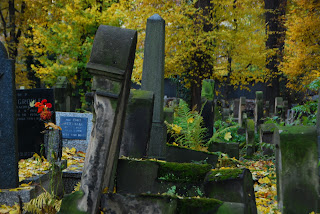We took a train from Warsaw south to Krakow, Poland. For those of you who have seen the film Schindler’s List by Steven Spielberg, most of it was filmed in Krakow. The movie was based on a true story of a businessman who saved Jews from the wrath of Nazis during WWII. We didn’t tour the Schindler factory and museum, but we did take a hour and half bus ride to Auschwitz. Auschwitz was one of the largest death camps used by the Nazis and was only partially destroyed after the war. The camp was actually divided into three separate camps. We first toured Auschwitz I were many of the original buildings still stand. We were able to see the bunks, toilet facilities, and cells of the prisoners. In some of the rooms there huge piles of clothes, shoes, suitcases, hairbrushes, and the most shocking, a large pile of hair taking up the hole length of the room, all taken from the prisoners as they entered the camp. After the two hour tour of Auschwitz I, we took a short 3 km bus ride to the second area of the camp known as Birkenau. This is what most people think of when they hear the name Auschwitz. It had over 300 prison barracks holding up to 200,000 people and was where the murder of huge numbers of Jews took place. The Nazis built railroad tracks into the camp, which are still there, so they could more efficiently off load people into the gas chambers. When Birkenau was fully operational, there were five gas chambers each with their own crematoria. Standing at the back of the camp and looking over the vast area, it was horrifying to think of how systematically the Nazis tried to exterminate an entire population of people.
The next day, we needed something a little bit less an intense, so we jumped on another bus to the Wieliczka Salt Mine. The salt mine was in operation for over 500 years and is now on the Unesco’s World Heritage List. The mine is no longer used today, but is now basically one of the coolest tourist traps I’ve seen. There are statues, chandeliers, and altarpieces all carved out of salt. One of the biggest and the most impressive of the chambers was the Chapel of the Blessed Kinga. This room took 30 years and over 20,000 tons of rock salt was removed to carve out.
Our last day in Krakow, was spent wandering around Old town. And what European Old town wouldn’t be complete without a tour of the castle and a church? Wawel Castle sits onto top of hill and we toured the State rooms and the Crown Treasury & Armory. Unlike the other castles we have visited during our travels, this one had a Dragon’s Den with a fire breathing dragon! We also visited the 14th century St Mary’s Church. My opinion is that it was the most beautifully ornate church we’ve seen on our trip. The focus of Old town is Rynek Glowny. It is Europe’s largest medieval town square, and at its centre is the 16th century Renaissance Cloth Hall.
While we were in Krakow, we ate some really good Polish food. Besides piergos and kielbasa, we had wonderful onion soup and a traditional potato pancake topped with a mushroom cream sauce at a cute little restaurant. We actually went there twice it was so good! There was a little bakery just downstairs from the apartment we were in where we would get fresh bread and pastries every morning. On our last night we ate at a bar mleczny (milk bar). These little cafeteria style restaurants are leftover from the communist era and they serve traditional foods more or less. I had a wonderful garlic soup and J had the sour soup which actually was really good despite its name! After eating our dinner, it was time to head to the train station to take the night train to Budapest. It should be interesting!
 |
| New Jewish cemetary |
 |
| Pile of shoes at Auschwitz |
 |
| Railroad tracks and Birkenau gate from the middle of the camp |
 |
| Chapel in the salt mine |
 |
| Fire breathing dragon outside his den |
0 comments:
Post a Comment